Personalization strategy: A roadmap to create an effective plan in 2024
From segmentation to AI-rich optimization capabilities, the combination of customer data, powerful testing, and real-time website personalization is transforming the possibilities of the digital world. See how.


Every marketer wants to provide the perfect customer experience. Personalization is about customizing a person’s online experience to their needs and desires based on in-depth insights about them.
They're only likely to buy if the journey takes them to the buying moment without seeming pushy. So, in a way, improving the conversion rate is the ultimate goal of personalization.
The rise of tools has meant more data and scope for personalization. And technological advancements are thrilling. Yet, many times, it also leads to efforts going the wrong way. Like:
- Ad hoc implementation of off-the-shelf features without understanding what need they’re solving.
- Poor data with no actual insights around the implementation of a personalization strategy.
- Lack of rigorous process to hypothesize, test, and validate landing pages and ideas.
- Limited resources to sustain the messaging that supports personalized target segments.
There are 4 pillars to personalization: Data, technology, strategy, and testing. In this blog, we’re sharing a roadmap for using personalization to create the most effective marketing strategy.
The three steps:
- Target in real-time
- Build and "WOW"
- Measure ROI
Step 1: Assess and target in real-time
Personalization starts and ends with understanding your audience, defining their needs, and serving them content that fulfills those needs in real time.
For your strategy to work, you have to predict visitor intent and match it with dynamically updating segments. You can do this by defining custom audiences based on profile data, omnichannel behavior, and data points.
Overall, it all starts with understanding customers' data.
For success, you can start with the 6C strategy to get deeper insights into your customers.

Image source: Forrester research’s the power of data
For your data to work as actionable insights, it should:
- Be reliable, directional, actionable, and relevant to the company's strategy.
- Be collected at appropriate moments and used to take a visitor to the buying moment.
- Be monitored, managed, and measured for showing ROI and success.
Further, focus on these questions to determine the maturity of your personalized marketing.
Q1. Do you have enough data about my customers?
If you're just getting started with personalization campaigns, at least have your fundamental audience segments in place. These might be larger cohorts at first, focused on visitor location, visitor device use, single visitor behaviors, or visitors coming from an ad campaign. However, with integrations, you can enrich data from any source and scale your personalization program.
Q2. Do you have the resources to do personalization effectively?
To create an effective personalization strategy, focus on implementing it as a continuous process. Have:
- A marketing team in place that is data-driven and validates your approach through experimentation
- A tool like Optimizely to help you personalize your marketing efforts with clicks, not code so you show relevant product recommendations.
- A set of metrics and enough resources to regularly update customer segments as you scale your personalization granularity

Q3. Do you have a process for validating ideas?
Your marketing campaigns and consumer personalization can only be as good as the customer data you’ve collected. So how can you ensure you’re collecting useful data that will assist you in decision-making?
And every idea is a hypothesis until it is tested. Your assumptions about your best audience segments, and the best messaging for those segments, are assumptions until they have been validated.
A great personalization strategy focuses on retention and relevant content by:
- Gathering customer insights and demographics.
- Validating those insights. It improves customer engagement.
- Understanding which ideas are valid for your target audience and create growth for your business.
Without a process in place, you will not achieve customer satisfaction and end up wasting resources using the wrong messaging for the wrong audience segments.
Step 2: Build and “WOW” with data
Every digital experience that you want to personalize should be easy to create, manage, and prioritize for different audiences without any developer help. The personalization tool you use should help you see exactly how a personalized experience will look to visitors.
Data helps you find ideas for different touchpoint that will actually work with your target audience and personas. The quality of your insights about your customers directly impacts the quality of your personalization results.

Three types of personalization insights to explore for improving customer journey through automation:
1. Deductive research
Are there general theories that apply to your particular business situation? Psychological principles? UX principles? General patterns in your data? ‘Best’ practices?
Deductive personalization starts with your assumptions about how your customers will respond to certain messaging based on existing theories... However, it doesn’t end there. With deductive research, you should always feed your ideas into experiments that either validate or disprove your personalization approach.
2. Inductive research
Are there segments within your data and test results that you can analyze to gather personalization insights?
If you are already optimizing your site, you may have seen segments naturally emerge through A/B testing. A focused intention to find these insights is called inductive research.
For example, there are potentially new ways of customizing the shopping experience for different age segments on an ecommerce website. Such as:
- Reducing distractions and adding clarity for older visitors
- Providing multiple products in multiple tabs for younger visitors
Initiatives like this improve customer relationships and also your clients can use these insights to inform their age-group segmentation efforts across their site.
3. Customer self-selected personalization
Customer self-selected personalization is potentially the easiest strategy to conceptualize and implement.
With self-selected personalization, you’re asking your users to self-identify, segmenting themselves, which triggers specific messaging based on how they self-identify. And then you can test the best approach for each of those segments.
There are two major areas of test, so you can find out:
- What are the best segments?
- What is the best messaging for each segment?
Step 3: Measure ROI
In its basic form, personalization covers two components:
- WHAT: the change you make in the default digital experience
- WHO: delivered to a specific user or group
For example, change the homepage hero banner for your returning customers.
However, to show ROI, it's important to get a breakdown of personalized experience to summarize the what, why, and how of a campaign.
For that, you have to test your personalization strategy. This way it becomes the equivalent of personalized Experiments. It has three components:
- WHAT: the change you make in the default digital experience
- WHO: delivered to a specific user or group
- WHY: find out if the change meets the original objective/goal
For example, test changing the homepage hero banner for returning customers to reduce bounce rate.
Ultimately, your personalization strategy will depend on which component your situation needs to prioritize as a starting point.
Three takeaways
Here are the three most important takeaways to create a personalization roadmap:
- To target in real time, you need quality insights, machine learning, and a process to validate your ideas.
- Focus on changing the WHAT, delivering to WHOM, and achieving the WHY.
- Great programs segment their users, personalize, test, and quickly learn. They are results-oriented.
Think of the bigger picture...
To create the most effective personalization strategy for your business, you must remember what you already know. For some reason, when companies start personalization, the lessons they have learned about testing all of their assumptions are sometimes forgotten.
You probably have some great personalization ideas, but it is going to take iteration and experimentation to get them right.
A final note on personalization: Always think of it in the context of the bigger picture of marketing optimization.
Insights gained from A/B testing and experimentation inform future audience segments and personalized messaging, while insights derived from personalization experimentation inform future testing hypotheses. And so on.
If you want to keep learning about successful personalization and improving user experience, here are three resources for you:
